

 Vol. 39 (# 21) Year 2018. Page 8
Vol. 39 (# 21) Year 2018. Page 8
Tatiana S. DEMCHENKO 1; Peter KARÁCSONY 2; Mikhail V. VINICHENKO 3; Maksim V. DEMCHENKO 4; Alexander V. MELNICHUK 5
Received: 12/01/2018 • Approved: 16/02/2018
ABSTRACT: The article considers the forms of the youth involvement in social control of the implementation of the youth personnel policy in the company management system. The empirical study has been conducted to determine the level of youth involvement in social control of the implementation of the youth personnel policy. The study was conducted with the use of a set of sociological methods and statistical analysis methods: a questionnaire survey with the use of the Google Forms online service and the SPSS Statistics 23 software package; an analysis of documents; a content analysis; a regression analysis. Based on the generalization of knowledge set forth in the scientific literature and the results of a specific sociological survey, it was found that the most applicable forms of the youth involvement in social control of the implementation of the youth personnel policy in the company management system were as follows: submitting to the company management the claims for the violation of rights and legitimate interests (20.2%); the involvement of respondents in public discussion of draft legislative acts (orders, decrees, federal laws and other acts regulating the company’s activities) (13.1%). The most effective forms of the youth involvement in social control of the implementation of the youth personnel policy in the company management system were as follows: filing claims to the company (3%), participation in rallies, strikes and other protest events to stand upon one’s rights to implement the youth personnel policy in the company management system (2.5%). The result of the conducted regression analysis made it possible to determine the intensity of the growth of the number of participants in rallies, strikes and other protest events to stand upon their rights to implement the youth personnel policy in the company management system in case of an increase in the number of participants in rallies, strikes and other protest events in various social spheres in the context of modern Russian reality. |
RESUMEN: El artículo considera las formas de participación de los jóvenes en el control social de la implementación de la política de personal juvenil en el sistema de gestión de la empresa. El estudio empírico se realizó para determinar el nivel de participación de los jóvenes en el control social de la implementación de la política de personal juvenil. El estudio se realizó con el uso de un conjunto de métodos sociológicos y métodos de análisis estadístico: una encuesta de cuestionarios con el uso del servicio en línea de Google Forms y el paquete de software SPSS Statistics 23; un análisis de documentos; un análisis de contenido; un análisis de regresión. Con base en la generalización del conocimiento establecido en la literatura científica y los resultados de una encuesta sociológica específica, se encontró que las formas más aplicables de la participación de los jóvenes en el control social de la implementación de la política de personal juvenil en el sistema de gestión de la empresa de la siguiente manera: someter a la administración de la compañía los reclamos por la violación de derechos e intereses legítimos (20.2%); la participación de los encuestados en la discusión pública de los proyectos de actos legislativos (órdenes, decretos, leyes federales y otras leyes que regulan las actividades de la empresa) (13.1%). Las formas más efectivas de participación de los jóvenes en el control social de la implementación de la política de personal juvenil en el sistema de gestión de la compañía fueron las siguientes: presentación de reclamos a la empresa (3%), participación en mítines, huelgas y otros eventos de protesta. los derechos de implementar la política de personal juvenil en el sistema de gestión de la empresa (2.5%). El resultado del análisis de regresión realizado permitió determinar la intensidad del crecimiento del número de participantes en mítines, huelgas y otros eventos de protesta para defender sus derechos de implementar la política de personal juvenil en el sistema de gestión de la empresa en caso de una aumentar el número de participantes en mítines, huelgas y otros actos de protesta en diversas esferas sociales en el contexto de la realidad rusa moderna. |
The development of the youth personnel policy in the company management system is the most important condition for the successful development of modern companies. The modern model of the youth personnel policy is based on the mutual responsibility of the state and the youth, on recognizing the youth as a participant in its formation and implementation; it is focused on the development of partnership relations with the youth.
Nowadays, companies are competing for highly qualified young specialists and the companies implementing an effective youth personnel policy in the company management system are given priority. As the social practice shows, this problem is solved if the forces and means of social control of the implementation of the youth personnel policy in the company management system are used.
The problem of social control in society was defined and solved in the distant past. For example, its theoretical foundations in the Russian scientific literature were developed by V.G. Belinsky, N.Y. Danilevsky, N.A. Dobrolyubov, P.Y. Chaadaev and other researchers in the late nineteenth and early twentieth centuries (Belinsky, 1954; Danilevsky, 2008; Dobrolyubov, 1896; Chaadaev, 2005). Scientists considered protest forms of social control: pressure on power, uprisings, protests, riots, strikes. The practical application of these protest forms existed long before the introduction into scientific circulation and the study of a phenomenon of "social control" in the scientific literature. The results of the content analysis showed that in the history of Russia about 42 major uprisings and riots were known. The most famous of them were as follows: Bolotnikov’s Rebellion (1606-1607), the Salt Riot (1648), Razin’s Rebellion (1660-1670), the Copper Riot (1662), Streletsky Riots (1682 and 1698), Pugachev’s Rebellion (1773-1775), the Decembrist Revolt (1825), the First Russian Revolution (1905-1907), the October Armed Rebellion (1917) and other rebellions.
In the foreign science, the aspects of social control were investigated in the works of G. Tarde, E. Durkheim, Ch.H. Cooley, T. Parsons, E. Ross and others (Tarde, 1969; Durkheim, 1991; Cooley, 2001; Parsons, 1951; Ross, 1969).
The social control theory began to be developed since the publication of G. Tarde's scientific work "On Communication and Social Influence" at the end of the nineteenth century. The scientist introduced this concept and defined it as "a means, a tool of returning persons with antisocial behavior to the socially significant activity", to the behavior consistent with generally accepted social standards (Tarde, 1969). G. Tarde considered social control only as a means of preventing deviations in society. Nevertheless, the scientist laid the foundation of this theory, giving his followers the possibility to develop it in more detail.
In modern scientific literature, scientists considered social control forms as applied to regulating activities in various spheres of public life, as well as in the management of a social organization (Bučar Ručman, A., 2016; Rodet, 2016).
Social control as a subject of sociological research was considered in the works of Baker N.D., Grant Ludwig L., Inazu J. and others (Baker, & Grant Ludwig, 2016; Inazu, 2017).
In modern scientific literature, the importance of social control in the social-labor sphere is noted in a context marked by fierce competition in the modern labor market (Yastrebova, 2016).
Social control is not an end in itself in the management, but it serves as an element of achieving specific goals of leadership, social groups. Social control of the youth personnel policy serves as a basis for identifying problematic areas in relations between the management and young employees. Therefore, it is important to develop a universal mechanism for creating favorable conditions for the development of the youth, talented young specialists in a company (Misra, & Walters, 2016; Bondaletov et al., 2014; Wharton, & Blair-Loy, 2002), to continuously improve working and learning conditions (Rogach et al., 2016; Vinichenko et al., 2016). It is important to introduce innovative technologies in the formation of personnel policy, in relations with the youth (Gureva et al., 2016). The involvement of highly skilled management personnel in order to implement an effective youth personnel policy is the most important factor for survival and development of modern companies (Frolova, 2014).
In general, a clearly defined scheme for enhancing participation of young people in achieving the effective use of their potential in the internal and external labor markets through social control is of particular importance.
The research of the youth involvement in social control of the implementation of the youth personnel policy in the company management system was conducted with the use of a set of sociological methods and statistical analysis methods: a questionnaire survey (using the Google Forms online service and the SPSS Statistics 23 software package); an analysis of documents; a content analysis; methods of mathematical data processing (a regression analysis).
The empirical study was conducted within Russian companies; a study group included employees of the Moscow Region companies.
The general population was 19.7 million people; the sample size was 365 people with a sample error equal to 4.76% and a confidence coefficient equal to 95%.
In the formation of the sample population, a multistage sample was used, based on a phased selection.
In the process of forming the sample population at the first stage, by means of cluster sampling, the general population was divided into relatively compact structural parts – clusters, namely the companies of Moscow and the Moscow Region. The selection of companies was random.
At the second stage, the selection of employees working in a company was carried out using a quota sample. Quota features were as follows: sex, age of a respondent.
The sampling adjustment procedure was carried out in order to improve the quality of the primary sociological information received.
The online survey involved the employees of companies, whose average age was 29.8 years old; the survey participants were separated by gender in favor of women (86%). The average salary of the respondents was 39,000 rubles.
The study found that less than half of the respondents (41.3%) believed that their participation in studies would contribute to the improvement of the youth personnel policy and social mechanisms in their companies. 22.4% of the respondents responded negatively and 36.3% of the respondents found it difficult to answer ( Figure 1).
Figure 1
The results of the survey of respondents on the question: "Do you think that
your participation in such studies and the results obtained will contribute to
the improvement of the youth personnel policy and social mechanisms for its
implementation in your company?"
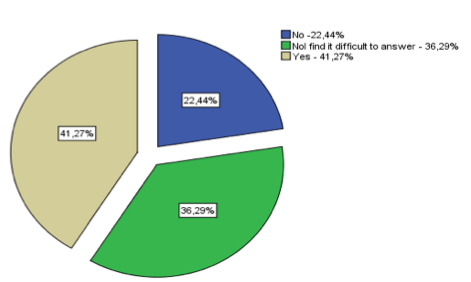
It should be noted that 73.7% of the respondents have never addressed the company management with claims for the violation of their rights and legitimate interests. Only 1/5 of the respondents informed the management about their dissatisfaction and violation of their rights (20.2%) ( Figure 2).
Figure 2
The results of the survey of respondents on the question: "Have you addressed
the company management with claims for the violation of your rights and legitimate interests?"
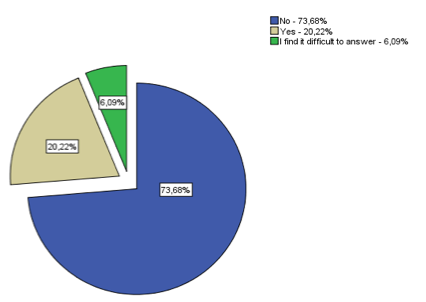
Only 3% of the respondents applied to the court with claims against the company, while 94.2% of respondents have never done this ( Figure 3).
Figure 3
The results of the survey of respondents on the question: "Have you applied to
the court with claims against the company, where you are working now,
or against the companies, where you worked before?"
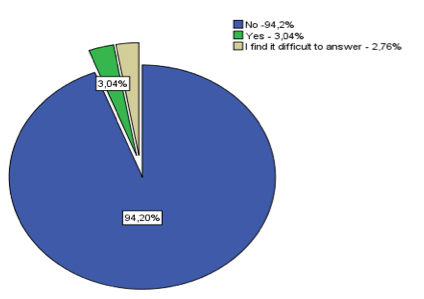
The youth involvement in social control of the implementation of the youth personnel policy in the company management system was also measured by an indicator of "participation in rallies, strikes and other protest events to stand upon one’s rights to implement the youth personnel policy in the company management system". The research results showed that only 2.5% of the respondents took part in such protest activities once or twice ( Figure 4).
Figure 4
The results of the survey of respondents on the question: "Have you ever taken
part in rallies, strikes and other protest events to stand upon your rights to implement
the youth personnel policy in the company management system?"
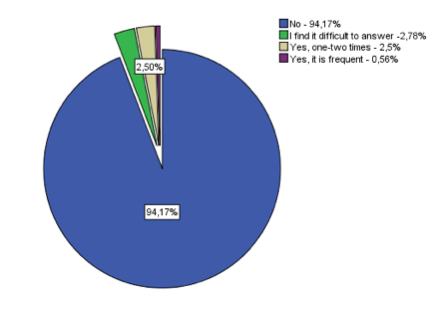
In this regard, the results of the regression analysis are of particular relevance. The linear dependence of two variables – dependent and independent ones – was identified and described by means of a simple linear regression. The influence of a change in the number of participants in rallies, strikes and other protest events in various social spheres (an independent variable) on the number of participants in rallies, strikes and other protest events to stand upon their rights to implement the youth personnel policy in the company management system (a dependent variable) has been determined (Table 1).
Table 1
Linear dependence of two variables – dependent and independent ones
Regression analysis coefficients |
|||||
Model |
Non-standardized coefficients |
Standardized coefficients |
t |
Significance |
|
B |
Standard error |
Beta |
|
|
|
(Constant) |
2.229 |
0.093 |
|
23.997 |
0.000 |
Participation in rallies, strikes and other protest events in various social spheres |
0.260 |
0.032 |
0.399 |
8.207 |
0.000 |
a. Dependent variable: Participation in rallies, strikes and other protest events to stand upon one’s rights to implement the youth personnel policy in the company management system. |
|||||
In addition, the results of the empirical study revealed that only 13.1% of the respondents had ever taken part in public discussion of draft legislative acts (orders, decrees, federal laws, etc.) regulating the activities of the company, where the respondents worked ( Figure 5).
Figure 5
The results of the survey of respondents on the question: "Have you ever participated
in public discussion of draft legislative acts (orders, decrees, federal laws, etc.)
regulating the activities of your company?"
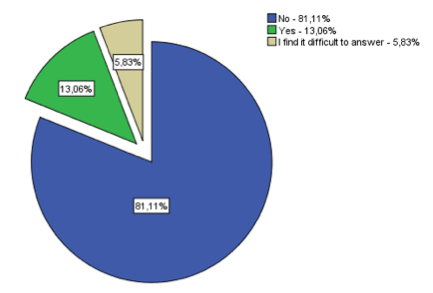
Conducting studies on the identification of public opinion in companies objectively influences the process of the youth involvement in social control of the implementation of the youth personnel policy in the company management system. The obtained results show that 58.7% of respondents (22.4% of respondents responded negatively and 36.3% of respondents found it difficult to answer) do not believe that their active participation in the research and the results obtained can contribute to the improvement of the youth personnel policy in their company.
The competitive environment, within which modern Russian companies conduct their activities, obliges them to be more vigilant and identify dangerous trends in a timely manner. This process can be successfully implemented by a comprehensive analysis of modern practices, the labor market, competition, the legislative framework, as well as by means of a public opinion survey of social control agents (company’s employees).
In such circumstances, the company management needs to conduct the targeted work on the study of public opinion by using feedback to inform the public about the study results and the measures taken based on the results of the studies conducted. Such measures will further activate the activity of social control agents (company’s employees), and increase the level of their involvement in participation in research. As a result, the confidence in the company management will be enhanced and the frequency of using protest forms of social control will be minimized.
As is known, the use of protest forms in informal social control is the most effective method in social control of the implementation of the youth personnel policy in the company management system.
The results of the conducted research showed that addressing the company management with claims for the violation of rights and legitimate interests was the most applicable form of the youth involvement in informal social control. This was noted by 20.2% of the respondents.
The analysis of the research results showed that such forms of the youth involvement in protest informal social control as filing claims to the company (3%), participation in rallies, strikes and other protest events to stand upon one’s rights to implement the youth personnel policy in the company management system (2.5%), were used in a limited way, but there were many factors that could activate these processes, for example: the imperfection of the personnel policy in a company, negative changes in the legal framework, negative changes in the company’s organizational structure, negative changes in the personnel incentive system, etc.
The regression analysis results (see Table 1) made it possible to determine the dependence of the variables "the number of participants in rallies, strikes and other protest events in various social spheres" and "the number of participants in rallies, strikes and other protest actions to stand upon their rights to implement the youth personnel policy in the company management system".
In this example, the regression equation is as follows (1 and 2):
The developed regression model predicts that an increase in the number of dissatisfied citizens and an increase in the number of participants in rallies, strikes and other protest events in various social spheres per 100 people cause an increase in the number of participants in rallies, strikes and other protest events to uphold the rights to implement the youth personnel policy in the company management system per 28 people (3).
The result of the regression model may seem insignificant at first glance. However, it is not so if we extrapolate the obtained value to the general population (19.7 million people), taking into account the standard error of the coefficients (0.093 and 0.032, see Table 1), which estimate the accuracy for the identified coefficients (2) when the model results are transferred from the sample to the general population. Thus, on the general population the regression coefficients obtained (2.229 and 0.260) will vary within plus/minus 0.093 and 0.032, (4) and (5) respectively.
Such deviation is insignificant for the given general population. In this regard, the analysis of the results showed that an increase in the overall activity of civil society structures led to a significant increase in their activity in upholding the rights in the implementation of youth personnel policy in the company management system.
The frequency of the use of protest forms of informal social control can be minimized by involving respondents in public discussion of draft legislative acts (orders, decrees, federal laws and other acts regulating the company’s activities); however, only 13.1% of the respondents participated in such public events.
The analysis of the results of the questionnaire survey showed that the reasons why respondents had not taken part in public discussion of draft legislative acts were as follows:
- a respondent did not know about such opportunity – 24.3%
- a respondent was not interested in such public activities – 26.8%
- a respondent was not interested in changes in this area – 5.7%
- a respondent found it difficult to answer – 34.2%
- other responses – 9%.
The research results allow drawing the following conclusions: a quarter of respondents do not know about the existing opportunity to participate in public discussion of draft legislative acts (24.3%), they do not know the algorithm and the procedure for participating in such events. One third of the respondents (26.85 and 5.7%) lack an active social position, they are not interested in such social activities and any changes. Besides, one third of respondents (34.2%) found it difficult to answer, so it can be assumed that they are also not involved in the studied form of social control.
The obtained results indicate that a significant number of young specialists can be involved in the application of negative informal sanctions expressed in protest forms of social control.
Based on the analysis of the results of the empirical study, the following conclusions on the youth involvement in social control of the implementation of the youth personnel policy in the company management system can be drawn:
1. Modern companies pay attention to the youth involvement in social control less than it is required by the current conditions and public needs.
2. The most applicable forms of the youth involvement in social control of the implementation of the youth personnel policy in the company management system are as follows: submitting to the company management the claims for the violation of rights and legitimate interests (20.2% of the respondents); the involvement of respondents in public discussion of draft legislative acts (orders, decrees, federal laws and other acts regulating the company’s activities) (13.1% of respondents).
3. The following forms of the youth involvement in social control of the implementation of the youth personnel policy in the company management system are the most effective, but less applicable for objective reasons: filing claims to the company (3%), participation in rallies, strikes and other protest events to stand upon one’s rights to implement the youth personnel policy in the company management system (2.5%).
4. The results of the developed simple linear regression made it possible to determine the influence of a change in the number of participants in rallies, strikes and other protest events in various social spheres on the number of participants in rallies, strikes and other protest events to uphold their rights to implement the youth personnel policy in the company management system. The regression model allows forecasting the growth of participants in protest events in the company management system.
5. The existing system of public discussion of draft legislative acts needs to be rationalized in order to inform and involve the youth in the discussion of draft legislative acts.
The reported study was funded by the Russian Foundation for Basic Research (RFBR) upon research project No. 17-03-00289.
Baker, N.D., & Grant Ludwig, L. (2016). Disaster Preparedness as Social Control. Critical Policy Studies, 1-20.
Belinsky, V.G. (1954). Polnoe sobranie sochinenii: Tom 5. Stati i retsenzii (1841-1844) [Complete works: Vol. 5: Articles and Reviews, 1841-1844]. Moscow. (p. 780).
Bondaletov, V.V., Medvedeva, N.V., Senicheva, L.V., Frolova, E.V., & Santos E. (2014). Local Politics, Business, People: Issues and Cooperation Strategies. Journal of Advanced Research in Law and Economics, 5(2), 63-73.
Bučar Ručman, A. (2016). Družbeno nadzorstvo in mednarodne migracije: Analiza nadzorstva od globalne do lokalne ravni [Social Control and International Migration: An Analysis of Control from the Global to the Local Level]. Dve Domovini, 43, 11-22.
Chaadaev, P.Ya. Filosoficheskie pisma [Philosophical Letters]. Moscow. (p. 178).
Cooley, Ch.H. (2001). Chelovecheskaya priroda i sotsialnyi poryadok [Human Nature and the Social Order] (N.M. Smirnova, & O.A. Zotov, Trans.). Moscow: Ideya-Press; Dom intellektualnoi knigi. (p. 327).
Danilevsky, N.Ya. (2008). Rossiya i Evropa [Russia and Europe). Moscow: Terra-Knizhnyi klub. (p. 702).
Durkheim, E. (1991). O razdelenii obshchestvennogo truda. Metod sotsiologii [About Division of Social Activities: Method of Sociology]. Moscow: Nauka. (p. 572).
Frolova, E.V. (2014). Deformatsii mezhbyudzhetnykh otnoshenii v Rossiiskoi Federatsii: sotsialno-ekonomicheskie i politicheskie riski [Deformations in Interbudget Relations in the Russian Federation: Socioeconomic and Political Risks]. Aktualnye problemy ekonomiki, 8(158), 351-359.
Gureva, M.A., Kirillov, A.V., Vinichenko, M.V., Melnichuk, A.V., & Melnichuk, Y.A. (2016). Management of Innovations and Innovative Process: Concept, Essence, Classification and Diffusion. International Review of Management and Marketing, 6(S6), 147-153.
Inazu, J. (2017). Unlawful Assembly as Social Control. UCLA Law Review, 64(1), 2-52.
Misra, J., & Walters, K. (2016, April 18). All Fun and Cool Clothes? Youth Workers’ Consumer Identity in Retail Clothing. Work & Occupations. doi: 10.1177/0730888416644949
Parsons, T. The Social System. New York: OUP. (p. 372).
Rodet, C.S. (2016). Social Order in a Fragile State: Rio’s Favelas. Economic Affairs, 36(3), 309-317.
Rogach, O.V., Frolova, E.V., Kirillov, A.V., Bondaletov, V.V., & Vinichenko, M.V. (2016). Development of Favorable Learning Environment and Labor Protection in the Context of Harmonization of Social Interaction of Educational System Objects. IEJME – Mathematics Education, 11(7), 2547-2558.
Ross, E.A. (1969). Social Control. A Survey of the Foundations Order. Cleveland, London. (p. 416).
Skabichevsky, A.M. (1896). Nikolai Dobrolyubov. Ego zhizn i literaturnaya deyatelnost [The Life and Literary Activities of N.A. Dobrolyubov] (Vol. 2). Saint Petersburg: O.N. Popova. (p. 236).
Tarde, G. (1969). On Communication and Social Influence. Chicago: The University of Chicago Press. (p. 256).
Vinichenko, M.V., Frolova, E.V., Maloletko, A.N., Bondaletov, V.V., & Rogach, O.V. (2016). Main Directions of Creating a Favorable Learning Environment and Labor Protection in the Interest of Enhancing Health of the Personnel and Students in Education Foundation. IEJME – Mathematics Education, 11(5), 1163-1174.
Wharton Amy S. and Blair-Loy Mary (2002). The “Overtime Culture” in a Global Corporation: A Cross-national Study of Finance Professionals' Interest in Working Part-time. Work and Occupations, 29(1), 32-63.
Yastrebova, A.I., Salomatkin, A.S., Dzhavakhyan, R.M., Redkous, V.M., Filonov, V.I. Civil public organizations for providing a public order and their role in forming of civil society. 2016. Journal of Advanced Research in Law and Economics. 7(2), 417-425.
1. Russian State Social University, 129226, Russia, Moscow, Wilhelm Pieck St., 4, bld. 1, e-mail: tstarshinova@mail.ru
2. University of Selye János, Komárno, Slovak Republic, e-mail: karacsonyp@ujs.sk
3. Russian State Social University, 129226, Russia, Moscow, Wilhelm Pieck St., 4, bld. 1, e-mail: mih-vas2006@yandex.ru
4. Financial University under the Government of the Russian Federation, 125993, Russia, Moscow, Leningradsky prospect, 49, e-mail: demchenkomv@mail.ru
5. Russian State Social University, 129226, Russia, Moscow, Wilhelm Pieck St., 4, bld. 1, e-mail: mav68@outlook.com